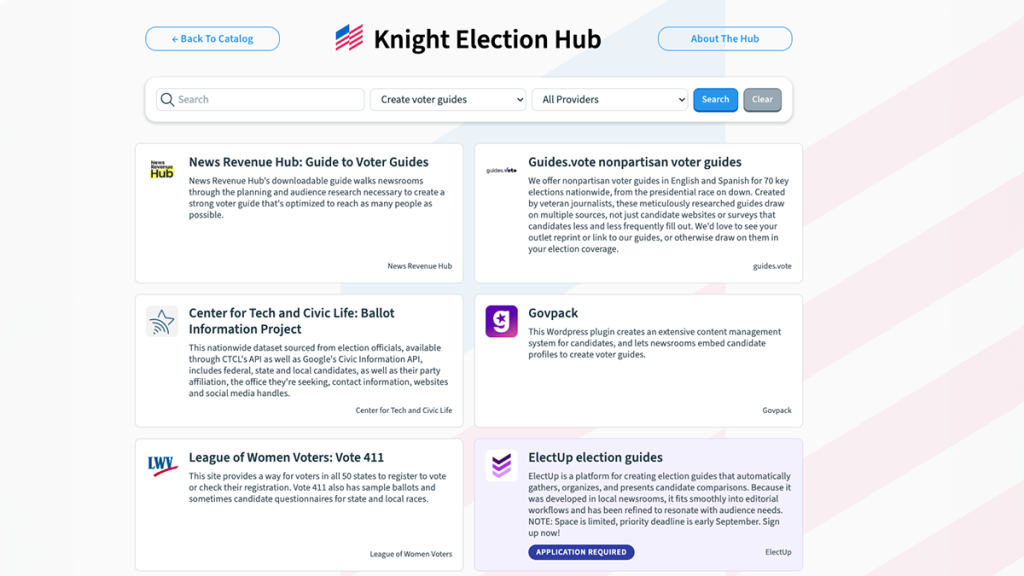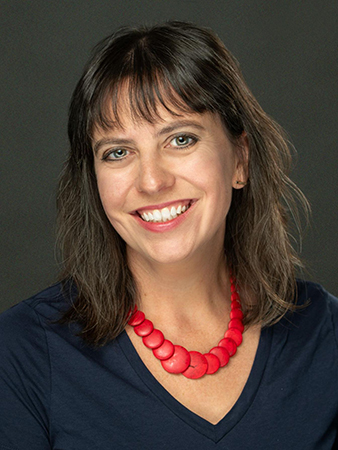
Key questions to consider when building voter guides
A conversation with Erica Peterson, Knight Election Hub

Working in public radio and nonprofit newsrooms for most of her career, Erica Peterson has seen the impact that voter guides can have for both newsrooms and the communities they serve. Not only does this content help fill an important information need, but the value of these guides often draws in new audiences, newsletter sign-ups and even donations.
Now, Peterson is working on a grant-funded initiative from the Knight Foundation to help newsrooms produce comprehensive voter guides for the 2024 election. She spoke with our Innovation in Focus team to share some practical tips and tools that she’s discovered while working in and alongside newsrooms on sharing actionable voting information.
Obianinwa: Can you walk us through your process if you’re creating a voter guide with a newsroom for the first time?
Peterson: The first step is to think about the scope of the voter guide. Consider the kind of geographic area you are trying to cover, how far down the ballot are you going, and what kinds of information are you going to include?
I am a huge proponent of going all the way down the ballot because I think those are the places where people don’t have access to a lot of really good information about candidates. Generally, I think people go into a voting booth knowing, “oh, I’m voting for this person for president,” or “I’m voting for this person for governor or Senate,” but then they see judges or county sheriffs, and most people aren’t as prepared to vote for those categories. Determining that scope will help you also determine the kind of resources you’re looking to put into the voter guide.
You might decide that you’re going to include every single race on your ballot, but I think you also have to give yourself the leeway to say, you know what, we’re looking at 30 different races here. We’re going to tell you who’s on your ballot and some basic information for all of them, but these three or four races are really important, consequential, competitive, whatever the case may be. These are the races that we’re going to devote some additional resources to, whether it’s a standalone story or more of a profile of these candidates. And just because you do that for one race does not mean you have to do it for every single race.
Obianinwa: How can newsrooms make these guides a great user experience so people actually utilize them?
Peterson: Once you determine your deadline and work backwards from that deadline, you need to think about how voters are likely to use your guide. What is the user experience going to be:
- Do you want it to be a one-stop-shop where, if I vote in the city, I can find who is likely to be on my ballot?
- Is there a reason to do a separate guide for one particular race and make sure the information is linked to each other?
I like to look at these guides and think: How many doors are there? How are people likely to find this information? And however they do, make it easy for them to find the other voter guide pages, the rest of the information.
You also have to think about things like SEO. Most of the traffic in these guides come from search, which is great because it’s a lot of people who are maybe not familiar with your newsroom and are finding you because they’re looking for voter information.
Obianinwa: Do you have any tips or insights when it comes to covering larger geographic regions for elections or voter guides?
Peterson: The voter guide I did for the West Virginia primary had about 1800 candidates on it, and that was a lot. The first step was knowing, “Here’s what we can expect, and it’s not a written profile of every single candidate.” That would have been impossible for us to pull off. It’s knowing that I’m committing to getting the name, political party, position, and when possible, social media links and websites for these candidates, and that is where the bar is.
Also, there are ways to access large quantities of data and use those to give you kind of a scaffolding for these guides. In my case, from the West Virginia Secretary of State, you can download a CSV of all the candidates, their email addresses, phone numbers and addresses. So that gave me something to go off of. And there are outside groups, like Ballotpedia and the Center for Tech and Civic Life, which have access to these huge datasets, some of which you have to pay for, but will give you some of this basic information.
Obianinwa: What tools have you found helpful in creating voter guides?
Peterson: The tool I’ve been using is called Govpack, which I think is really useful for creating some of these basic voter guides that give people the tools to research the candidates themselves. It’s an open-source plugin for WordPress, so you have to be on WordPress to use it. There are some others depending on what else you want to do with your voter guides.
There’s a tool called TurboVote, which is an embed that will tell people basic information about where to vote, the dates, things like that. On the Election Hub, there are a number of resources for voter guides, including, a pretty cool guide about using emojis and other icons in voter guides to give people, like, an easy way to judge candidates, tools like Ballotpedia or Elect Up. It kind of depends on what you’re looking for out of your voter guide.
Obianinwa: Can you tell us a little more about the Knight Election Hub for anyone who isn’t familiar with it?
Peterson: The Knight Election Hub is a resource catalog of dozens of tools, most of which are free, but even I, who have covered elections as a journalist, wasn’t familiar with some of them. There are some interesting datasets that I would have found useful when I was doing reporting around elections, expert directories, embeds, things like that. And then there are a variety of tools that normally cost money that journalists can apply for and Knight is picking up the tab.
An example is a tool called Elect Up that will let you create candidate surveys with really cool embeds. There are free tools to use on election night for results. There are trainings through groups like Sunlight and Hearken to help people reach new communities and background candidates.
Part of my job right now is working on that hub with Scott Klein, who is a Knight Foundation Entrepreneur in Residence with Newspack. And the other part is working with newsrooms, especially newsrooms that haven’t done voter guides in the past, to talk about how they might go about this and strategies for doing voter guides, including, but not limited to, using this tool called Govpack that I’ve used extensively in the past.
Obianinwa: Any other advice you want to share for newsrooms building voter guides?
Peterson: These guides should mention basic information like where you can vote, what you need to bring with you. Even if this information is likely on the Secretary of State’s website, you should have it all in one place and present it to your audience, too. But you should also think about including other non-candidate information, like “what exactly does the assessor do?” I found people are really interested in salaries, too: is this a volunteer position? What do they get paid? But if you don’t know what a position like assessor or conservation supervisor actually does, how are you supposed to make an informed decision about who to vote for? Including information like that is useful, and that’s copy that your newsroom can use year after year.
Obianinwa: How have you seen news organizations involve community members in the information gathering process for voter guides?
Peterson: I think it’s really useful, after you do the first voter guide, to survey your audience. And that is something that our audience manager at Mountain State Spotlight did after the primary, and it was useful. Most of the comments were very positive and said this was so helpful, and we’re so glad you do this. And then there was constructive criticism, saying, “Hey, I’d like more information about this or that.”
Also, these voter guides are only one prong of an election strategy. Ideally, they’re one thing a newsroom produces, and then there are other reporting and products that go along with it. One of those things is taking more of a Citizen’s Agenda approach and really talking to voters about what kinds of questions they want candidates to answer. What are the issues in their community? Sometimes those are things that you can incorporate directly into a voter guide. For example, in West Virginia, for the general election, the reporters are going around the state and talking to people in all the counties, and I’m going to be incorporating that coverage and those links into the county pages of the voter guide.
To learn more about how to access voter guide support and election tools through the Knight Foundation, you can email her at govpack.erica@gmail.com.
Editor’s Note: This interview has been edited for clarity and brevity.

Sign up for the Innovation in Focus Newsletter to get our articles, tips, guides and more in your inbox each month!
Cite this article
Obianinwa, Chioma (2024, Aug. 26). Key questions to consider when building voter guides. Reynolds Journalism Institute. Retrieved from: https://rjionline.org/news/key-questions-to-consider-when-building-voter-guides/
